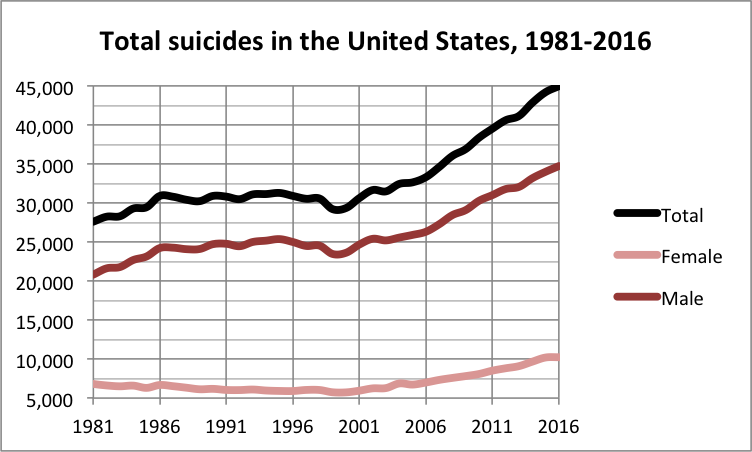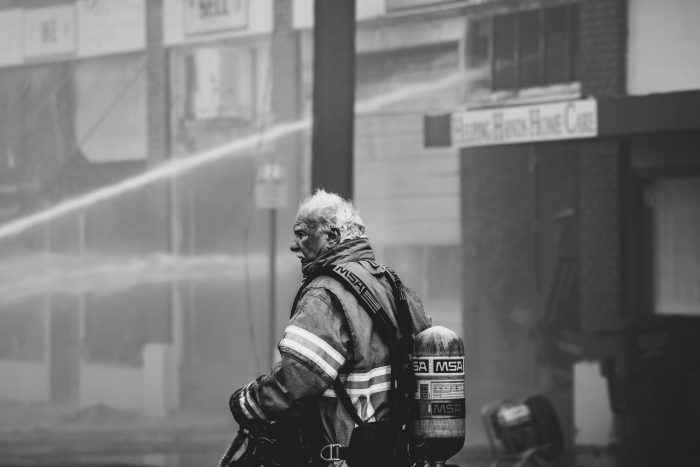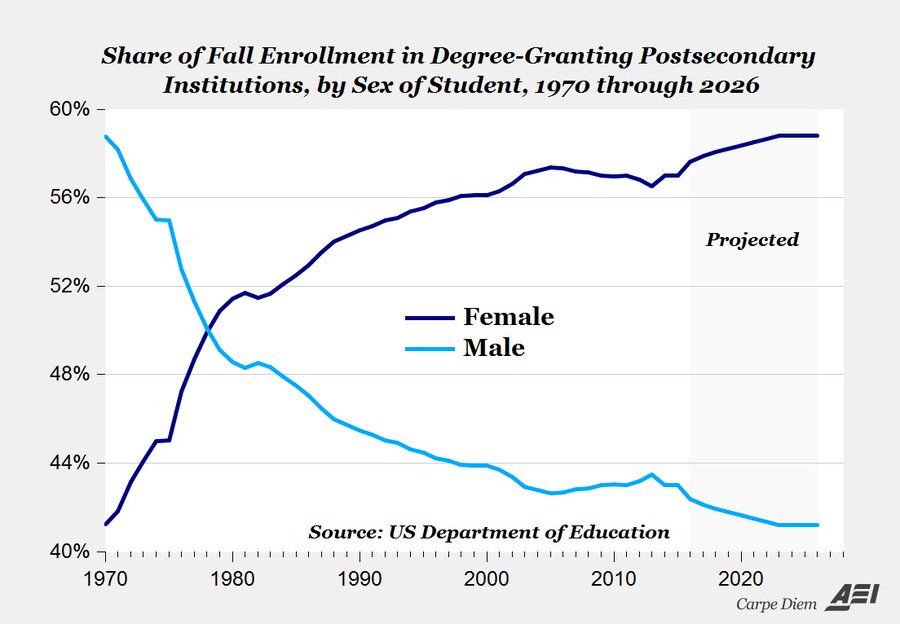Let’s start with a few questions:
- How much more or less likely are men to kill themselves than women in the US?
- How much more or less likely are men to get a postsecondary degree, such as a bachelor’s or trades degree?
- How much more or less likely is a man to be killed than a woman?
If you listen to all of the rhetoric railing against toxic masculinity, the very real costs that men bear for it are often concealed by its victims: domestic abuse, rape, shootings, glass ceilings, etc. These are true, but much of the rhetoric around toxic masculinity has focused on how it affects others, not themselves. Men are just as much victims of toxic masculinity as women. Below are charts that show the direct costs in mental health, education, and violence that men are suffering from today and, if trends continue, will only suffer more deeply in the coming decade.

Notice the sharp uptick in 2005 – well before the financial crash that many have blamed on the mental health crisis.
 These differences are often blamed on a culture of toxic masculinity, with newer, more caring alternatives being offered to supplant the destructive archetypes that’s at the root of this suffering, but where are the results?
These differences are often blamed on a culture of toxic masculinity, with newer, more caring alternatives being offered to supplant the destructive archetypes that’s at the root of this suffering, but where are the results?
Since the turn of the 21st century, an attack on traditional masculinity was in full swing. Although it hadn’t yet reached the full-blown mainstream status that it’s enjoying now, it had already captured universities. In 2000, bell hooks published All About Love, a collection of reflections about the importance of love and how men, in particular, have been conditioned to reject or be suspicious of it. In the 2004 documentary, I am a Black Man, hooks said:
The whole construction of black masculinity as we know it is so mired in patriarchal thinking within a white supremacist capitalist patriarchy that the black man can’t begin to liberate themselves without interrogating and questioning how sexism has shaped the nature of black masculinity.
At my university, this rhetoric was common. Traditional ideas of masculinity were predicated on white patriarchy. Tear down that culture and what would follow was a more compassionate, just, and balanced society that worked for all. Never mind the fact that such attitudes were not, in fact, the direct result of a white supremacist capitalist patriarchy, otherwise how could such similar values be found among the hyper-masculine samurai of Japan or among the warrior class of Thailand for centuries. But that ideology enchanted me to the point that I even wrote a lengthy essay on the implicit sexism in Darwin’s Origin of Species and how the “objective” research in biology was colored by a male-centered lens.
As my generation started to rise through the ranks of different industries, this belief spread and captured institutions ranging from film companies to fashion brands. Now, you have the 9-1-1 series offering more healthy alternatives to masculinity with a lead star who loves kale and encourages his colleagues to be kinder to themselves. Countless male actors have opened up about their struggles with depression and addiction. Fashion brands have pushed back against the hyper-masculine aesthetic with more androgynous models. But has it worked?
No. Suicide rates among teens have been sharply on the rise, starting in 2004 and taking a sharp uptick in 2014. Between 2014 and 2017, the suicide rate among boys rose a whopping 10% per year. And then just look at the shootings. All of the mass shooters have been men, most teenage boys. And while the reaction to this has been trying to dismantle more and more of the toxic masculinity supposedly at the root of this, consider how in the 50s and 60s, the supposed hey-dey of toxic masculinity, gun ownership was rampant. Hundreds of pictures are floating online of young children loading hunting rifles in classrooms, but where were the shootings? Nowhere to be found.
These new ideas around masculinity were supposed to make men stronger, more caring, more resilient and, ultimately, chip away at the roots of a violent, troubled society. It has failed. Supporters might claim “we just need more time, this work takes generations.” Nonsense. Yes, changes in cultures might take generations, but we should see clear downward trends after over twenty years of this seeping into our culture. The facts are out. The man problem is getting worse, not better. And the attempt at remolding masculinity is partially to blame.
Some claim that the main drivers are more instability, greater pressures from the stresses of a decaying economic system, and so on, as if to say that these are new phenomena. They aren’t. Humans have dealt with far greater levels of stress, anxiety, and pressure than a teenager in the wealthiest, most powerful country in the world has faced in the last two decades, none of which has resulted in these staggering shortfalls. My homeland, Thailand, is a more corrupt, more volatile, more desperate, poorer country than the US, there’s widespread gun possession, yet it’s only had one shooting. Ever.
I work with teens on a regular basis and I see how poorly boys respond to the slogans of the new masculinity. Gentle organizations fail boys. Again and again. Girls can still thrive in such an environment, but the boys will wither. I’ve seen it too many times in my own life, and I’m now seeing its effects on American culture.
Boys don’t need more kindness, to get better in touch with their emotions, and to have more safe spaces. Those are good things, in moderation, but I don’t think it answers the fundamental hunger at the heart of the masculine. They need challenge. They need action. They need difficulty. They need purpose and mission. They need rules and consequences. They need real consequences beyond getting a good grade at the end of the term. They need men who they can look up to and emulate.
Working with teens over the last five years, I’ve seen countless boys turn from hopeless troublemakers to upright gentleman that were the pride of their parents and teachers. The turn-around happened when they got more structure, more challenge, more purpose, and someone to kick ’em in the pants and tell it to them straight: “Get your shit together, son.” And having a role-model or culture that tells that to them again-and-again. What’s now being pushed as the solution: more safety, more empathy, more kindness, more love, are going to leave men further behind while they pander to women. It just doesn’t click. It’s been 20 years and it still hasn’t clicked. Time to rethink things.
We don’t need this new “healthy masculinity,” we need the masculinity that has served men for thousands of years: competition, struggle, hardship, challenge, toughness, purpose, action, and giving them real-world responsibilities with real-world consequences.
When we talk about what those ideas of masculinity are, they can be found in multiple warrior cultures reaching back thousands of years. Here’s one account from a famed French knight Geoffroi de Charny:
And through the great knowledge that these men have gained from the adventures they encountered in their youth and through what they learned and remembered from their experiences, they begin to act wisely on their own behalf when the need arises in their wars, and all goes well for them because of their good sense and the way they know how to conduct themselves; they also know well how to help and counsel others in their wars. And these good men in whom is to be found so much experience and bravery in the practice of arms are entrusted with the command of men-at-arms to lead them in combat as captains, constables, and marshals or in other offices concerned with the direction of the practice of arms. The quality of these good men-at-arms has been thus fully proved through their great physical exploits, through their strenuous efforts of endurance, through their good sense and wise counsel, through their great acts of true valor and their fine words, which are indeed fitting in relation to such deeds, through their splendid bearing, to be seen under the very difficult conditions often to be encountered in the practice of arms, whether winning or losing, through the great support which should and is to be found in them in all situations, and finally through the absence of any characteristics which could under any circumstances be criticized or condemned.*1
Geoffroi wrote this book as a handbook for his own order of knights during the Hundred Years War, although it has since become a classic textbook in what manliness. His advice echoes that found throughout myths and cultures stretching back thousands of years. First, young men need adventure and risk to grow. Second, courage, toughness, good sense, discipline, leadership, and eloquence are primary virtues. He’s not advocating deceptiveness, cruelty, or greed. And while our knowledge has advanced and, with it, more nuanced or modified ideas of masculinity with it, the fundamentals remain the same. The “healthy masculinity” often being on offer isn’t a slight modification, it’s a complete reversal of the virtues that have been at the root of manliness for millenia.
If we continue this course and embrace the new male ethos, addiction, depression, suicide, and violence will only rise in the face of a culture that continues to ignore the real needs of men. And it’ll be everyone, mothers, fathers, brothers, sisters, colleagues, and ourselves who’ll pay the price for our delusions.
*1: de Charny, Geoffroi. A Knight’s Own Book of Chivalry (The Middle Ages Series) (p. 81). University of Pennsylvania Press, Inc.. Kindle Edition.












Read 0 comments and reply